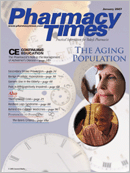Publication
Article
Pharmacy Times
Products for Relieving Osteoarthritis
Author(s):
Osteoarthritis (OA) affects approximately21 million individuals in theUnited States and is the leading cause ofdisability. While OA can affect individualsat any age, 70% of individuals older thanthe age of 70 have evidence of the condition,and OA is considered to be themost prevalent form of arthritis.1
Possible Causes of Osteoarthritis
There are a variety of causes of OA;examples include2:
- Age: Incidence increases with age
- Obesity: Weight gain increases thestress on an individual's joints
- Injury or overuse: Risk increases inathletes or individuals whose jobsrequire repetitive motionsthat can put stress on orinjure the joint area
- Genetics: Ongoing researchsuggests that certain genesmay be associated withdeveloping OA. Some individualshave an inheriteddefect in one of the genesthat make cartilage.
- Other medical conditions orother types of arthritis: Individualswith rheumatoidarthritis have a greater probabilityof developing OA.Individuals who have a historyof gout are also at agreater risk.
Treating Osteoarthritis
The goals of treating OA include reliefof pain, improving the mobility of joints,and improving the patient's quality of lifeby minimizing the effects of the condition.Treatment of OA depends on theseverity of the condition and may includethe use of pharmacological agents, physicaltherapy, and surgery, if needed.Nonprescription analgesics such as nonsteroidalanti-inflammatory drugs oracetaminophen are typically used for thiscondition to treat mild-to-moderate pain(Tables 1 and 2). In addition to the useof these agents, other therapies includethe use of topical analgesic products(Table 3), low impact exercise,weight loss, physical therapy, and heatand cold therapy.
Alternative Therapies
Results from a study published in theFebruary 23, 2006, issue of The NewEngland Journal of Medicine demonstratedthat a combination of supplementssuch as glucosamine and chondroitinsulfate seem to offer significantpain relief for patientswith moderate-to-severe arthritisof the knee3 (Table 4). Individualswith preexisting medical conditionsor those on other medicationsshould always check withtheir health care provider beforetaking any of these agents.
The Role of the Pharmacist
Before recommending anynonprescription analgesic products,pharmacists shouldassess the appropriateness oftherapy by evaluating thepatient's current medical history,current drug profile as wellas allergy history and screen fordrug-drug interactions andpossible contraindications associatedwith the use of these products.Patients should always be counseledon the proper use of these agents andshould be encouraged to seek furtherevaluation from their primary healthcare provider when warranted. In addition,pharmacists can make recommendationsabout nonpharmacologicmeasures that patients affected by OAcan incorporate into their treatmentregimen.
Ms. Terrie is a clinical pharmacy writerbased in Haymarket, Va.
References
1. Osteoarthritis. American College of Rheumatology Web site. Available at:www.rheumatology.org/public/factsheets/index.asp?aud=pat.
2. Osteoarthritis. Arthritis Foundation Web site. Available at: www.arthritis.org.
3. Glucosamine, Chondroitin Sulfate, and the Two in Combination for Painful KneeOsteoarthritis. New England Journal of Medicine Web site. Available at:http://content.nejm.org/cgi/content/abstract/354/8/795.







